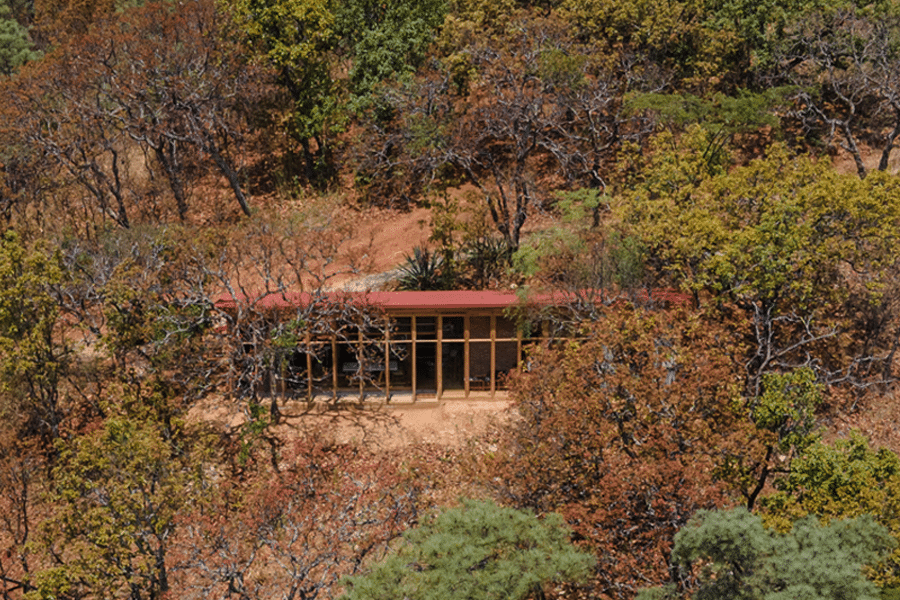Prefabricated housing is all the rage in the construction world. With the increased use of 3D printing, offsite fabrication of modular components and other technologies designed to assist rapid building on the rise, city dwellers around the world have grown used to luxury apartments and condominiums seemingly popping up overnight.
These high-tech building strategies are mostly used in urban centers, where the logic of the supply chain makes it easy for builders working on a large scale to use prefabrication to increase housing stock quickly, efficiently and affordably. But what about people in rural areas who are interested in taking advantage of these technologies? Mexico City-based architects Manuel Cervantes Estudio’s assisted self-production housing kits might be the answer.
Old ideas, new technology
While the technology used to build housing using components manufactured offsite is a novel idea in the world of commercial construction, Cervantes’ concept of using these same strategies for single-family housing actually has historical precedent.
From 1908 to 1942, Sears, Roebuck and Co. sold more than 70,000 mail-order home building kits to homebuyers throughout North America. Available in a variety of architectural styles, they were shipped throughout the United States on railroad box cars, which transported all the materials needed to build a complete home to the buyers.
When the kits arrived, homeowners would build their houses following the included instructions, relying on friends, neighbors and family members in the same way farming communities used to come together for barn raising parties.
Architect Manuel Cervantes wouldn’t comment on whether the Sears houses were a source of inspiration for him and his team, but he did say they were inspired to create the kits because they wanted to “show families vernacular and passive old ways of doing things.”
“Our inspiration comes from the need to help families to build their living spaces in a better and smarter way,” he said. Just like the Sears company worked to spread contemporary aesthetics and technologies like central heating, indoor plumbing, telephones and electricity to rural areas, Cervantes and his team hope their kits will help elevate home design in far-flung rural areas where there has historically been little access to architecture as a discipline.
Adaptable design
So far, the Manuel Cervantes Estudio team has assisted in the production of one DIY house, which they call Rural Nicolas Housing. Located in a mountainous, wooded region of Mexico, the house exemplifies many of the aesthetic values and design strategies that the team hopes future users of the assisted self-production housing kits will be able to use in the creation of their own homes.
“The organization of the house is about a flexible system of frames that allows users to play around with the scale in order to adjust to the people or the budget,” Cervantes said. Each kit is designed with adaptability in mind, enabling users to adjust the basic specs of the design to the specific requirements of their building site, aesthetic values or the needs of the family who will eventually occupy it.
In the case of the Rural Nicolas Housing project, the family used a variation on the basic design of the assisted self-production kit that would enable them to make the most of their lot’s gorgeous panoramic mountain views and the area’s temperate climate.
“The structure uses southern orientation to provoke a nice interior atmosphere,” Cervantes said. “There is cross ventilation available when needed, and the building is created using a wood structure and a very small amount of concrete, only in the mortar and the floor slab of the structure.”
When the team designed the assisted self-production housing kits, it wanted to make it as easy and affordable as possible for families to gather materials that would make vernacular sense within the context of each particular home. Unlike the Sears company, the materials used aren’t standard issue. Instead, each builder designs the kits so they can be used with whatever is cheapest and easiest for each family.
“Materiality is also something that we needed to be pragmatic about,” Cervantes said. “We design the kits so builders can use whatever materials they have on hand that are most affordable and effective. Sometimes the first step of construction is about finding donations, or getting local materials that obviously are efficient.”
A DIY approach to construction
Once the local builders have determined the best materials for their Manuel Cervantes Estudio-designed home, the fun of construction begins. “We design manuals so people can understand a better way to build things,” Cervantes said. “When we can, we assist them via pictures on the cellphone and verbal assistance.”
Throughout the construction process, clients can stay in close contact with the Manuel Cervantes Estudio team, asking questions and getting feedback about its design decisions. So far, Cervantes said the construction process has been relatively seamless for assisted self-production kit users. “The biggest challenge is probably staying on budget,” he joked.
For Cervantes, this back and forth with the client embodies the kind of responsive, flexible attitude toward domestic architecture that he hopes to promote with his assisted self-production kit project.
“The project comes from the analysis of the context, not just the physical but the social and economic context, of any given home,” he said. “That’s part of what we’re trying to do with this project—to show home builders how to do things always considering the tangible and intangible context of their home.” Imagining the next clients who will build their own assisted self-production homes, Cervantes said he had learned many lessons he hoped to apply. “What lessons have I learned for the future?” he asked. “A lot! Noble materials like wood are difficult to maintain, and people always look to avoid that. In general, I’ve learned that architecture is rigid in many ways for people. Our attempts at being pragmatic can be difficult, raising many emotions for families searching for life, not design.”












